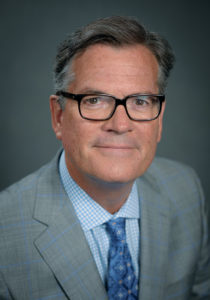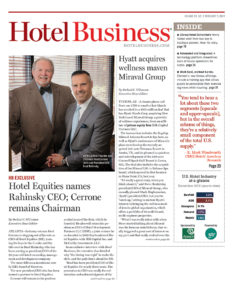NEW YORK—The upscale and upper-upscale segments, represented by some 77 brands in North America and the Caribbean according to STR chainscale data, cut an interesting swath across the U.S. lodging industry, both in their variety and ability to have footprints in different market tiers.
Aspirational cousins to the luxury segment, of the approximately 5.5 million hotel rooms in the United States today, STR data indicates some 700,000 of those rooms would be in upscale and 600,000 in upper-upscale.
“You tend to hear a lot about these segments, but in the overall scheme of things, they’re a relatively small component of the total U.S. supply,” explained R. Mark Woodworth, senior managing director, CBRE Hotels’ Americas Research.
Still, both segments have greatly resonated with consumers in recent years, at both the brand and independent levels, helping drive supply activity throughout the country.
“If we look back a couple of years, upscale supply grew 3.5% in 2014, 4.1% in 2015 and then we’re estimating for year-end 2016 that it grew at 5.6%. And to compare that to the industry as a whole, according to STR, for those three years going back to 2014, supply only grew 0.7% nationally in 2014; 2015 it grew one percent and we’re estimating 2016 it grew 1.6%. It’s a good three-to-four multiple of the national average, i.e., the level of new supply that’s been occurring in recent years in the upscale category,” said the executive. “Obviously, that’s a reflection of what consumers are saying they want so developers are delivering more product.”
Another key aspect of upscale has been the ability of developers to justify building more capacity. “Equity sources are confident in that particular tier and, critically, lenders have become comfortable that those hotel types do, in fact, make economic sense; the capital’s going to get a fair return,” observed Woodworth.
While the segment’s occupancy has been tracking up since 2014 (a 3.1% increase that year; 2015: 0.7%), Woodworth suggested a slight decline would close out 2016.
“Which simply means supply finally caught up with demand; all those new rooms were not fully absorbed,” he observed. “Having said that, as a chainscale, we’re estimating it finishes the year at 79.3% occupancy; benchmark that against the U.S. total at 65.3%. It’s a very significant occupancy-level premium relative to the average U.S. hotel. So very strong, very healthy chainscale segment. We see developers continuing to deliver a lot of inventory over the next three to five years. But we remain comfortable that it’s going to be readily absorbed, i.e., no threat of overbuilding from a national perspective within the upscale category,” said Woodworth.
One company banking on the upscale segment is Hilton Worldwide. The global chain late last month introduced its 14th product, Tapestry Collection by Hilton, a soft brand that at its launch had seven Letters of Intent and 35 more candidates in the works.
At the recent ALIS Conference in Los Angeles where Hilton debuted the new collection, President and CEO Christopher Nassetta told Hotel Business the move stems from talking—and listening—to the company’s customers, both existing and potential.
“What we found is there are a lot of customers at this price point [who want]hotels that are unique. Typically, independent hotels that are unbranded don’t fit within the confines of a hard brand, but it’s a product on occasion they want to stay in. [Tapestry] will afford us the opportunity to better serve our existing customers and bring a bunch of new customers into the system. It will index probably younger, not just the price point being a little bit lower, but the type of hotel. They won’t all be urban, but more urban than not. Very unique sort of hotels and in the end, I think a little bit of a lifestyle overlay,” said the CEO.
“Another very important constituency is owners,” Nassetta continued. “We found owners that we have, as well as owners we want to attract into the system, find it very appealing to be able to keep the identity of their hotel and keep its independence in one sense, but have all of the benefits of Hilton HHonors and all the commercial engines that help drive very high levels of market share.
“So you put together customers [and owners]telling us this is something they find appealing—it becomes a very easy decision,” said Nassetta.
The inked LOIs for the collection are in Syracuse, NY; Chicago; Nashville, TN; Warren, NJ; Hampton, VA; and two in Indianapolis. The first property is expected to convert to Tapestry Collection by third quarter.
The conversion aspect of the upscale segment also plays well with owners. CBRE’s Woodworth noted in terms of supply, “The higher up you go in the chainscale categories, the less likely you’re going to find your conversion brands. Yet, upscale is that one segment where you do see a fair number of both [conversions and new-builds]. I can think of a lot of Crowne Plaza conversions, certainly Radisson conversions, although, anecdotally I would say the vast majority of the new supply that’s come into the upscale chainscale segment has been new construction; it has not been conversions.”
At press time, CBRE’s forecast for upscale fundamentals showed occupancy for 2016 at 73.9%, edging downward (-0.6%) from 2015; ADR at $138.73, a positive 2.9% change over 2015; and RevPAR moving up 2.3% to $102.46 from 2015’s $100.12.
“We think the fourth quarter of last year came in right where we thought it was going to come in, so there was no surprise there. The economic expectations all seem to be meaningfully more optimistic going into 2017 now than they were even a few months ago. We’re going to be upgrading our forecast. I don’t think it’s going to be a big, big change, but going to be more optimistic than what we showed [previously],” said Woodworth.
He noted for the upper-upscale chainscale, 2016 was “another very attractive year. It was the first year that we saw a year-over-year decline (-0.3%) in occupancy but still finishing at a very attractive 74.1% for the full calendar year. If we go back to 2011, the year-over-year gains in occupancy went up 2.8%, then 2.2% (2012), 1.5% (2013), 2.3% (2014), 0.8% (2015). So, we’ve seen some very strong, consistent occupancy gains for a number of years. With supply slowly beginning to pick up with some pretty attractive increases in pricing, we’re seeing a little bit of push back on the occupancy side. But again, nothing that we see as being troubling at all. In fact, you’d argue at this point in the cycle, you’d expect to see that type of behavior,” said Woodworth.
CBRE’s forecast for upper-upscale ADR in 2016 showed ADR at $180.22, a positive 2.7% change over 2015; and RevPAR ticking up 2.4% to $133.47 from 2015’s $130.37.
“It’s going to be relatively balanced,” said Woodworth. “We’ll likely see some very minor occupancy declines in the near- to mid-term and again, I think that’s more of a function of supply growth picking up; prices are holding with some slight increases at a good level. Profits should remain very, very attractive in that category.”
In the upper-upscale segment, owners and developers also have the advantage of reinventing iconic or historic buildings via adaptive-reuse.
“Those are the kind of things developers are seeking,” observed Woodworth. “Oftentimes it’s more economically feasible to take an existing structure and either upgrade it in the case of an existing hotel or retrofit it. The classic one is the Old Post Office Building in Washington, DC, that Trump did (the 263-key hotel sits in the luxury segment). In Atlanta, I can think of at least one developer currently converting an office building into a hotel. John Portman [& Associates and Hirsch Bedner Associates] did an office building and converted it into Hotel Indigo Atlanta Downtown. There was an office building converted into a Courtyard by Marriott. We will continue to see more and more of that kind of activity.”
One of the challenges within the upper-upscale segment is negotiating a ground-up construction project.
“For an upper-upscale hotel, the numbers usually are going to be very, very challenging. Absent some public subsidy, it’s real hard to make the numbers work in the vast majority of markets,” said Woodworth.
The conversion of an existing structure for a different use also infers greater risk. “Therefore, it’s going to mandate a higher level of equity on the part of the developer; that’s absolutely something I would expect,” he added.
Upper-upscale supply has not grown as robustly as upscale in the 2011-2016 period. According to CBRE data, supply in 2011 grew 1.7% against demand growth of 4.5%; slowing to -0.1% in 2012 (with demand growth at 2.2%); increasing to 0.6% growth in 2013 (with demand growth at 2.1%); followed by 1.3% growth in 2013 (with demand growth at 3.7%); 1.2% in 2015 (with demand growth at 2%); and estimated for year-end 2016 at 1.5% growth with demand at 1.2%.
Asked if there are particular influencers that would drive developers toward the upscale or upper-upscale segments, Woodworth said CBRE is at the formative stages of some applicable research.
“Some of the initial observations do speak to the upper-upscale and upscale segments,” he said. “We’ve gone back to the mid-1980s and we’ve been studying how real personal income has grown by segment of the population. We’re interested in that we know historically, changes in demand have correlated very closely to changes in both employment and real personal income when one becomes more important than the other, depending on where we are in the cycle and the type of property we’re talking about.
What’s interesting is if we go back to 1988 through the end of last year, the median real personal income in the United States in real terms grew 7.8% over the past almost 30 years. When we look at just the 95th percentile, the top 5%, whereas the overall median was 7.8% growth, that top 5% increased by 30%,” said Woodworth. “If we look at the top 20%, i.e., the 80th percentile, it actually grew 21% over that same time frame. We’re still working on this but one of the things we’re seeing is if we compare that level of growth in the upper two categories, they do track very closely to the growth we’ve seen for upper-upscale and also luxury hotels,” Woodworth observed.
The executive also studied the past five years for each of the 60 cities that CBRE tracks very closely to see how supply, demand and RevPAR changed and how that data compares to the next five years for upscale and upper-upscale hotels. “In terms of supply, Austin over the past five years out of our 60 markets was number one. Supply for upper-price hotels in Austin grew at an average 5% per year. Compare that to New York at 4% and Nashville and Pittsburgh at 3.9%. At the other end of the scale you had places like St. Louis and Oahu that literally had no supply growth in the upper-price categories for the past five years,” he said. “When you think about developers and where they focus, the disparity that you see in the supply growth across markets in the upper tiers is pretty significant.
“So, if I’m a developer and I’m looking at what kind of hotels do I want to be building nowadays, not only has the absorption of upscale hotels been very attractive in the past three or four years, but we think the prospects for continued real income growth in those upper tiers remains very, very positive. We fully expect the demand for both upscale and upper-upscale hotels is going to continue to grow at a very attractive clip,” said Woodworth. HB


